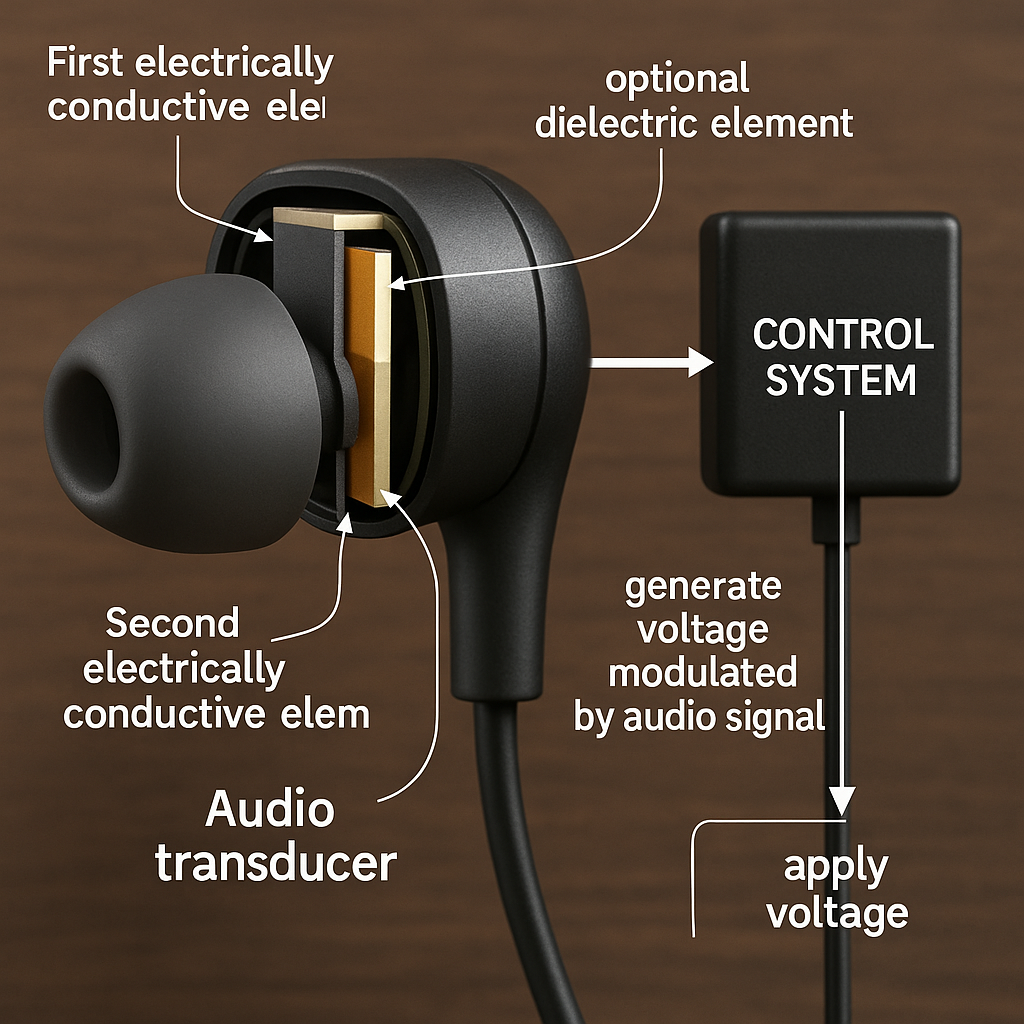Invented by Fallon; James J., Weiss; Stephen J.
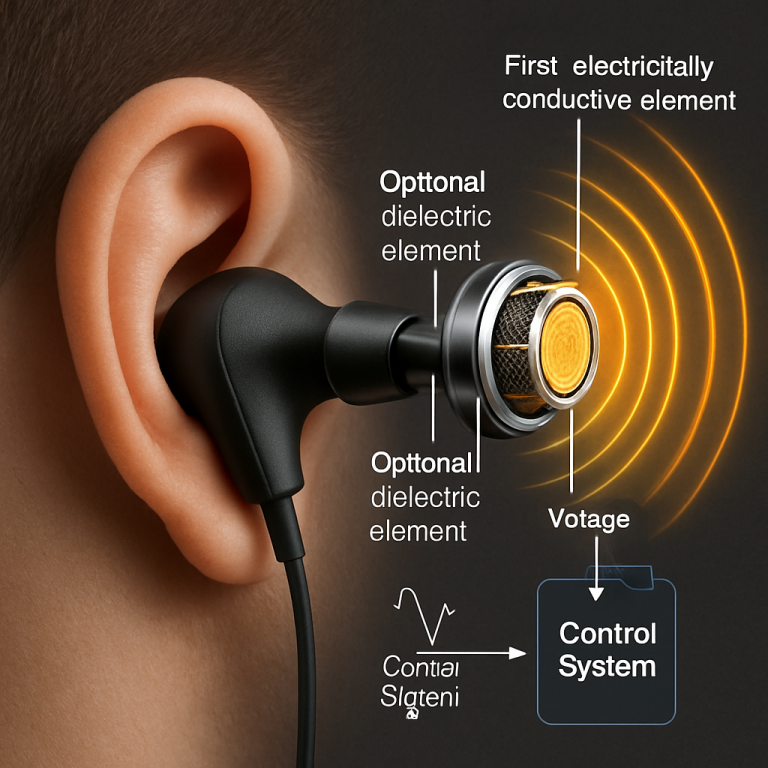
Audio technology keeps marching forward, and every so often, a new idea changes the way we listen. This article digs into a new patent application that introduces quantum effect audio transducers—a fancy phrase for a new way of making sound. If you’ve ever wondered how earphones and speakers could get smaller, clearer, and more immersive, this is the story for you. Let’s explore the market background, the science and old technology, and then see what’s truly new and clever in this invention.
Background and Market Context
To understand why this invention matters, let’s step back and look at how we got here. Speakers, headphones, and earphones have been around for over a hundred years. The basic idea is simple: some device makes the air vibrate, and our ears pick up those vibrations as sound. But while the idea is simple, making those air movements sound good, loud, clear, and real—especially in small gadgets—has always been hard.
The first telephone speakers were invented way back in 1861. Since then, audio engineers have tried to make sound more lifelike, devices smaller, and energy use lower. The big breakthrough in speakers came in 1924, with the moving coil speaker. These are the speakers most of us still use. They have a coil of wire, a magnet, and a thin round piece called a diaphragm that moves to push the air and make sound. These work well, but they are not perfect. They can be big and heavy, waste a lot of power, get hot, and sometimes don’t sound as crisp as we want.
As people started using more portable gadgets—phones, music players, laptops, tablets—the need for tiny, high-quality sound became more important. The rise of surround sound, virtual reality, and 3D audio made things even harder, especially for earbuds and small headphones. People now expect to hear sound coming from all around them, not just left and right, but from above, below, and behind. Modern systems like Dolby Atmos aim to do this, but when you only have one little speaker in each ear, it’s hard to really pull off the effect. The sound might feel flat or fake, and you lose a lot of the magic.
To make matters more complicated, people want their earphones to be comfy, light, and stylish—leaving even less room for big, heavy, or power-hungry tech. The market is desperate for a way to make sound that’s crisp, clear, and full, from the tiniest earbuds to the biggest headphones, while also supporting advanced 3D audio.
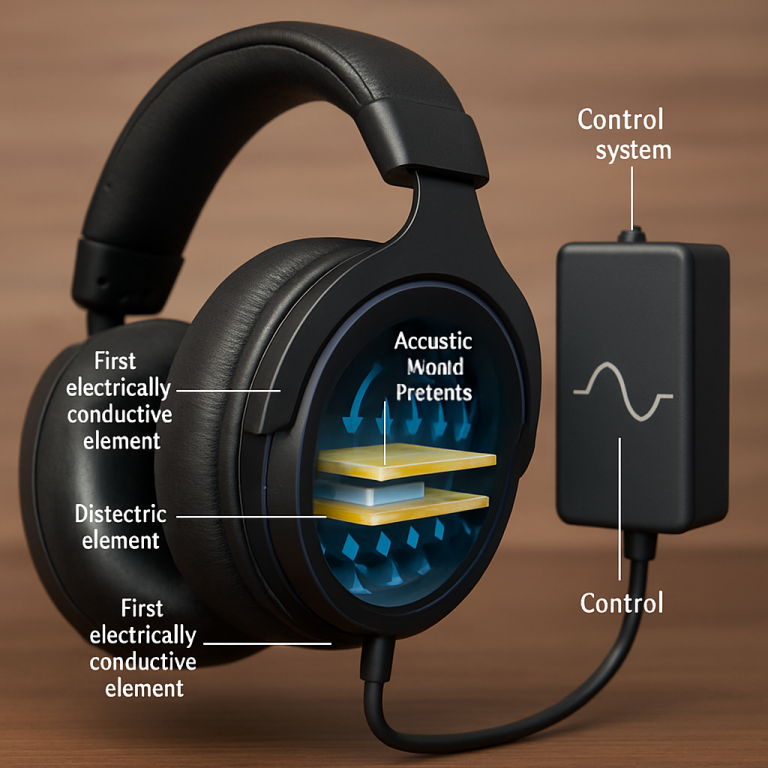
That’s where this new patent application comes in. It promises not just a small improvement, but a whole new way of making sound—by using electric fields and quantum effects instead of old moving parts. If it works as described, it could change everything from your next pair of earbuds to high-end studio speakers.
Scientific Rationale and Prior Art
Now, let’s look at what’s come before and why it wasn’t enough. Over the decades, engineers have tried many ways to make sound better, smaller, and more true-to-life. Here are the main types of speaker technologies and why each has limits:
Electrodynamic Speakers. These are the traditional coil-and-magnet speakers you find almost everywhere. They are simple and reliable but need space to move air well, especially for deep bass. Small versions can sound tinny or weak. Mechanical parts wear out, and distortion creeps in at high volumes.
Flat Panel and Planar Speakers. These use a thin, flat surface to make sound, with the moving part spread over a big area. They are thinner and lighter, but still rely on moving parts, and they often struggle to make deep sounds because the movement is limited. They can also get expensive and not always sound better than regular speakers.
Multicell Flat Diaphragm Speakers. Here, several small speaker cells are put together in a flat sheet. This can help spread the sound and boost clarity, but it makes the device heavier and more complex. Again, low sound frequencies are hard to produce, and special electronics are needed to match the audio signals, which can add noise and cost.
Electrostatic Speakers. These use thin plastic sheets coated with a conducting layer, placed between two metal grids. High voltage moves the sheet to make sound. They can sound really clear, but they need big, complex electronics, use a lot of power, and still don’t make deep bass well.
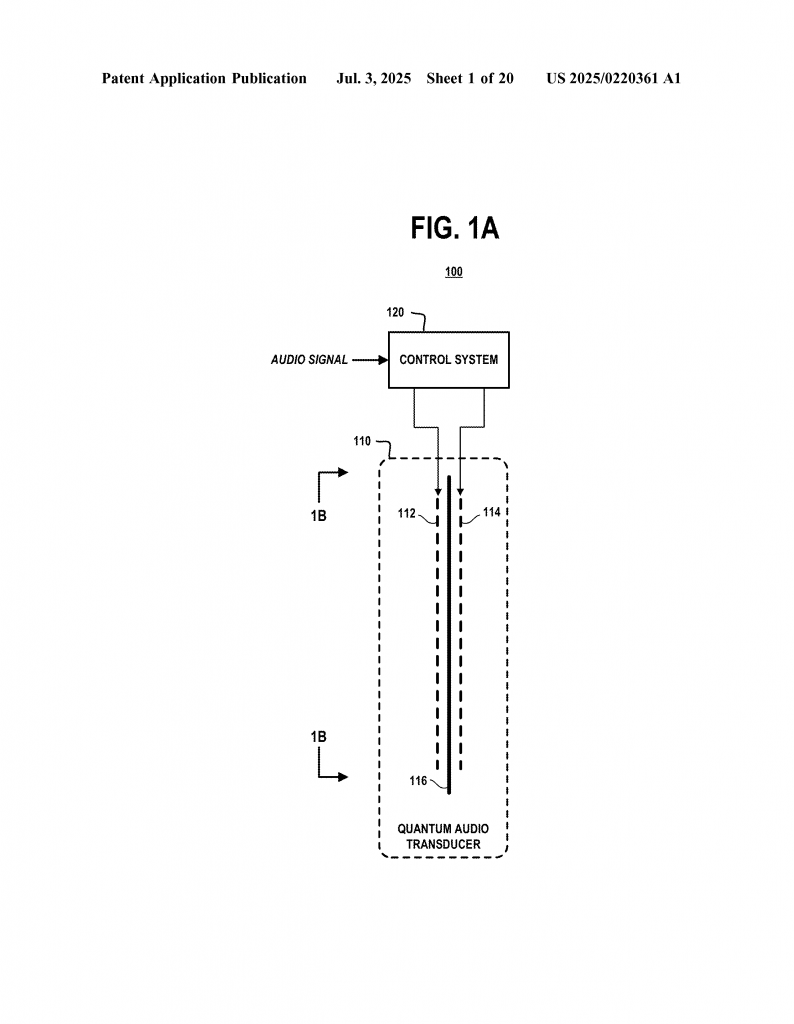
Ribbon Speakers. These use a thin metal ribbon between magnets. They sound great at high notes but have trouble with bass and are hard to make efficient. They can also be fragile and expensive.
Piezoelectric Speakers. These use special crystals that change shape when voltage is applied, making sound. They’re tiny and common in watches or alarms, but they can’t make a wide range of sounds, so they’re rarely used for music or voice.
Ion and Plasma Speakers. These use electric fields to move charged particles in the air itself to make sound. The idea is clever, but the devices are big, expensive, use lots of power, and can even make harmful gases like ozone. They are not practical for everyday use—even less so for something as small as an earbud.
None of these methods is perfect. Some are too big, others too expensive, and most can’t fit the need for true 3D sound in tiny earbuds or headphones. Usually, in-ear devices fake 3D sound with clever tricks—adding delays, changing volume, or using special audio processing. But with only one speaker per ear, there’s only so much you can do. You can’t really make sound come from above or behind; your brain just isn’t fooled.
All these old ideas share a few big problems: they need moving parts, they waste energy, they create heat, and they are limited by the size and quality of their mechanical bits. As soon as you shrink them down, you lose sound quality, especially for bass. More parts mean more weight, higher costs, and more ways for things to break.
What if you could make sound without moving parts at all? What if you could use electric fields, not magnets and coils, to move the air and make sound? That is the big idea in this new patent. By using quantum effects—meaning, in this case, the way electrons jump from a metal surface when pushed by an electric field—it’s possible to make air vibrate and create sound. The patent application even claims to do this at safe voltages, so you don’t make ozone or other harmful byproducts. If this works, it could mean simpler, lighter, and more powerful audio devices, with much better sound quality, and true 3D effects even in the tiniest earbuds.
Invention Description and Key Innovations
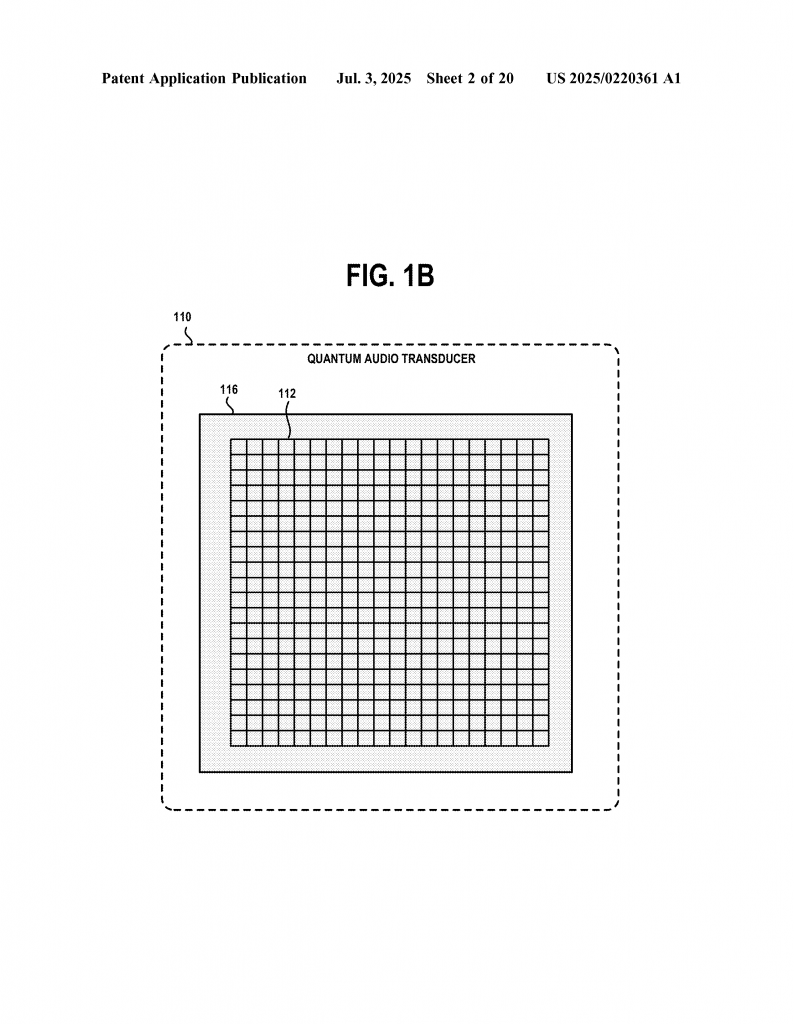
So, what’s really new here? This invention describes a sound-making device (called an audio transducer) that uses two metal pieces with a special insulator (dielectric) between them. Instead of moving a coil or a membrane, the device creates an electric field between the metal parts by applying a changing (modulated) voltage based on the audio signal. This electric field is strong enough to push electrons off the metal surface—without making harmful ozone—and those electrons bump into air molecules, making them wiggle and create sound waves that your ears can hear.
The basic building block is simple: a first electrically conductive element, a second electrically conductive element, and a dielectric element sandwiched between. The patent describes many ways to arrange and shape these parts: flat, curved, as grids or meshes, with holes for airflow, or even using special shapes like honeycombs or circles. The materials can be metals like copper or zinc, and the dielectric can be a thin plastic film (like polyimide or Kapton), or even just air in some cases.
What makes this approach powerful is that you can make lots of these little transducer cells and arrange them in arrays—side by side or in special layouts. For earbuds or headphones, you can fit several transducer cells in each ear, arranged in a circle, rectangle, or other shapes. Each cell can be controlled separately, meaning you can send different audio channels to different spots. This lets you create real 3D sound—if a movie or game says a sound should come from above or behind, you can send that part of the sound to the right cell, and your ear will really hear it from that direction.
The control system is smart, too. It can take in regular audio signals (digital or analog), break them into different channels, and drive each transducer cell with the right signal. The system can adjust loudness, boost or lower different frequencies, and even turn cells on or off to change the direction or focus of the sound. If you want more bass, you can crank up the voltage—which makes the electric field stronger and the sound louder—without worrying about big, heavy magnets or thick diaphragms.
This invention is not just for headphones or earphones. The patent describes how you could use arrays of these quantum effect transducers in regular speakers, soundbars, or even big concert systems. You could make speakers that are thinner, lighter, and more reliable—since there are no moving coils or magnets to wear out or get hot. You could even shape the sound beam, steering it like a flashlight, by turning on or off different cells or changing the timing of the signals. This could give you better privacy (sound just for you), or let you fill a room with sound from a tiny box.
The patent also tackles safety and efficiency. Unlike old plasma or ion speakers, the device works at low enough voltages that you don’t break up the oxygen molecules in the air, so you don’t make ozone. The device can use off-the-shelf materials and standard electronics, making it easy and cheap to build. The modular design means you can scale up or down, from a tiny earbud to a huge sound wall.
Some of the key technical tricks include:
– Using different shapes and patterns for the metal elements—flat, curved, grid, mesh, or even honeycomb—for better control of sound and efficiency.
– Making the dielectric thin and strong, so you get a big electric field without needing tons of voltage.
– Allowing the transducer cells to be set up right next to each other, or even overlapping, for maximum packing in small devices.
– Using a smart controller that can take in any kind of audio signal, slice it into as many channels as you want, and drive each transducer cell with its own signal.
– Arranging transducer arrays in mirror-image layouts for left and right ears, so 3D sound is real and not just virtual.
– Avoiding the need for big magnets, heavy coils, or complex moving parts, making the devices lighter, thinner, and less likely to break.
In practice, the patent even describes how you could make a pair of earbuds each with dozens of tiny transducer cells arranged in a circle or grid. The left and right earbuds would have mirror-image layouts, and the controller would send each piece of the sound to the right cell. For surround sound or 3D audio, this means you can have real spatial audio in your ears, not just a fake version. You could hear footsteps behind you, a bird above you, or music swirling all around you, with much more realism than any single-speaker earbud could ever give.
The patent also describes how to make these devices with standard plastics, metals, and electronics. You can print or etch the metal grids onto the plastic film, perforate the dielectric for airflow, and use standard amplifiers and transformers to get the right voltage. You can connect all the cells with simple wiring, and use software to manage the audio channels. The design even allows for heating the metal parts to boost electron emission if you want more sound output, or using different metals to tune the efficiency and safety.
Finally, the invention is flexible. You can make the arrays as big or small as you want, shape them to fit any device, and steer or focus the sound just by changing the signals. You can use them in open speakers, closed headphones, or even “bone conduction” or “open ear” devices. The system is compatible with all the latest audio standards, like Dolby Atmos, DTS:X, and other 3D formats, so you’re ready for whatever the future brings.
Conclusion
Audio technology is always moving forward—but it’s rare to see a new idea as bold as this. By using quantum effects and electric fields to make sound, this invention could break through the limits of old speaker designs, making audio devices thinner, lighter, more efficient, and much more immersive. For headphone and earbud makers, it offers a way to pack true 3D sound into the smallest gadgets, without the need for heavy magnets or moving parts. For consumers, it means better sound quality, longer battery life, and a more magical listening experience—whether you’re lost in a movie, gaming, or just enjoying music. As this technology moves from patent to product, it could change the way we hear the world, one electron at a time.
Click here https://ppubs.uspto.gov/pubwebapp/ and search 20250220361.
